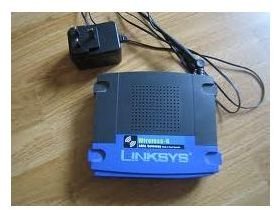Setting up an ADSL Modem/Router Combination
The modem is a device that provides access to the web by hooking up to your local cable service, your telephone service or a satellite dish you have mounted at your home or building. A router is another device that hooks up multiple computers to one modem, provides internal IP addresses to all such computers and provides firewall protection on the network.
Combining these two devices together has some advantages. The Internet service provider (ISP) usually provides the modem, and if the ISP provides a combination of router-modem, the ISP’s technical support helps in the eventuality of any technical issues or problems. If the router is separate from the modem, and you needed help with your router, most likely the ISP’s support cannot or will not help.
Basic Networking
The physical networking when setting up a modem/router is simple.
The first thing to do when setting up the modem/router is to hook it up to the phone or cable line. How to do this depends on the type of service available, and the type of input required by the modem router. Look for a spot on the modem/router that says “ADSL”, “Internet” or “Cable”, and identify the place to plug-in a phone cable or a coax cable alongside. Plug in the appropriate cable here.
After plugging in, an “Internet” or “Online” light usually starts blinking. Look for a line of four or five more inputs to plug in network cables, and use these to connect computers to the modem/router.
The primary challenge is to understand the different terminologies and methodologies used by the different modem and router manufacturers. Each manufacturer makes their devices a little differently, and some Internet service providers have companies make custom modem/routers design interfaces for their products. As such, the setup interfaces to configure the wireless settings vary, and very often set-up will require the support of the Internet service provider.
Some modems allow the choice of WEP or WPA encryption, but most offer only WEP. If it is possible, opt for the more secure WPA.
The Firewall and IP Permissions
Like setting up wireless, setting up firewall permissions and IP permissions depends on the modem/router interface, and again requires the ISP’s technical support.
A physical firewall, like the ones built into routers, help to protect all computers hooked up to the router from external assaults, such as hackers or viruses, by blocking incoming and outgoing information on ports for which it has no information. This means that if the user wants to use a program that needs a certain port, such as an FTP program or an online game, the system administrator first has to tell the firewall about the ports that need opening. The first step is to know which port to open. How exactly to open it depends on the specific modem/router, and is best left to the ISP’s technical support.
Typically, when a computer hooks up directly to the Internet, it gets a public IP. Viruses and hackers attack the IP. By hooking up a router, the router gets the public IP, thereby absorbing all attacks, and thus protecting all the computers hooked up behind it. To allow all the computers behind the router to reach the Internet, the router will dish out its own internal IPs. All routers use the same basic range, 192.168.x.x (the x’s can be any number between 0 and 256). The router uses these IPs to ensure that each computer on the home network gets the information requested and nothing else. Since file and printer sharing also depend on these IPs, the IP allotted to a specific computer does not change.
Use this basic understanding of what a modem and a router is, learn more about how to set up these devices, and find out what they can do to improve your home network so you can get started on a great networking career!
References
- Source: author’s experience
- Image credit: flickr.com/Gordon Joly under CC 2.0 license
